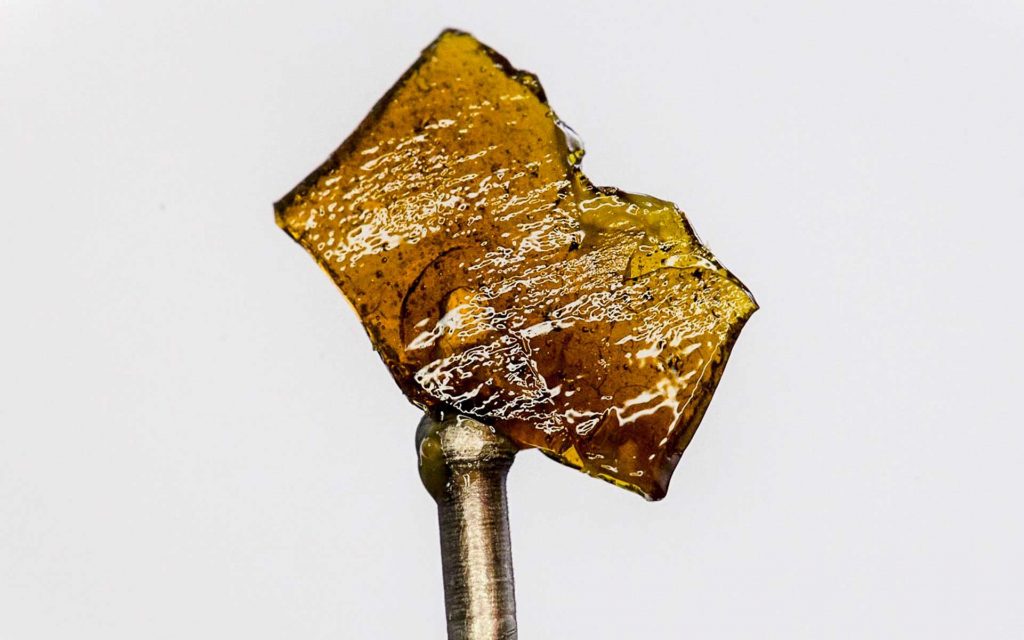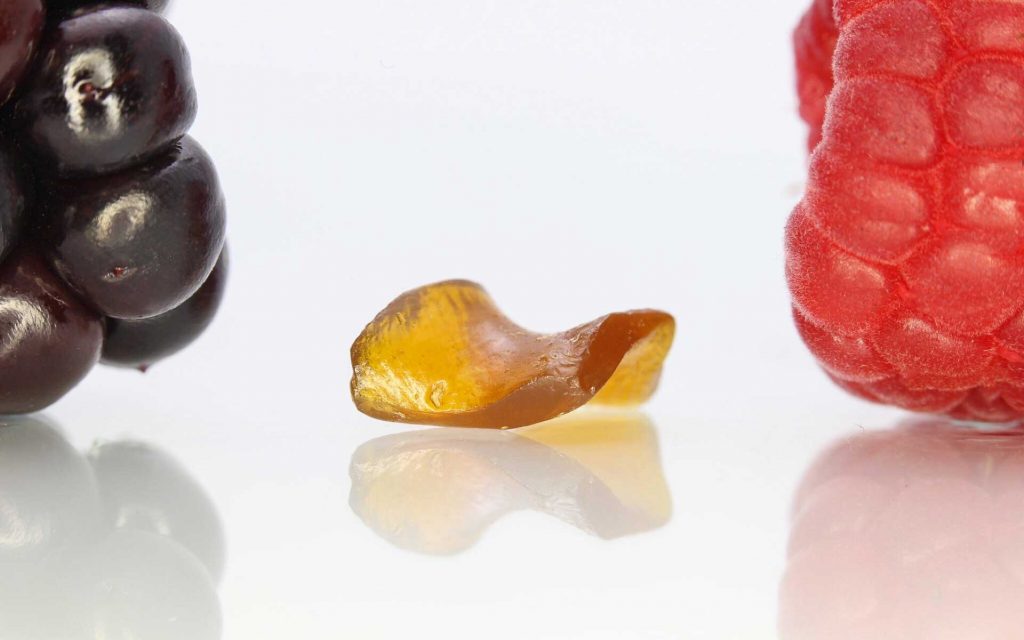This two-part series will show you how to photograph cannabis, regardless of your experience level. Get tips on how to take pictures of live plants, harvested buds, and concentrates, as well as how to shoot indoors and outdoors. There’s something for beginners, experts, and everyone in between.
Cannabis offers many different opportunities for photography, from flower to concentrates to live plants and much more. Concentrates are relatively new to the market and interest in them is growing quickly. Although not as common as photographing flower, concentrates have their own beauty.
The vivid yellow and gold hues of concentrates fold into layers of sticky, translucent goodness, showing a complexity of textures. The synthetic shapes and structures have their own appeal, much different than the natural forms of a growing flower.
Capturing images of concentrates may be a little more challenging than shooting flower because of the small size of concentrates. You’ll have to get creative with equipment to get an appealing image, and it might be a little more expensive to get into because of the gear needed.
Why Photograph Cannabis Concentrates?
 (Patrick Bennett for Leafly)
(Patrick Bennett for Leafly)
Because concentrates are relatively new products, concentrate photography is still a somewhat untapped field. Taking pictures of them will bring to light what they are, how to consume them, and encourage education of them.
Here are some other reasons to photograph concentrates:
Share on Social Media
Concentrate photography allows creatives to explore the cannabis plant from an entirely different perspective. Social media is great for connecting with others in the cannabis community and taking pictures of cannabis-related content other than flower is a great way to build diversity in your portfolio.
Keep a Tasting Log
Track the different kinds of concentrates that you try in a tasting log. Photography can add a new dimension, helping to categorize your experiences.
Keep a Grow or Processing Journal
Cannabis cultivation doesn’t necessarily end with tasting cured flowers after a harvest. For many, growing is a necessary means to an end for creating concentrates. Processing at home through various non-solvent techniques—like rosin pressing and water-hash processing—are becoming much more common. Photographing the production and sampling of cannabis by-products such as concentrates is a great way to shoot different subject matter.
Create Art Prints and More
The aesthetic that concentrate photography brings translates well into other non-digital mediums, such as art prints and textiles.
Photographing Concentrates vs. Flowers
 (Patrick Bennett for Leafly)
(Patrick Bennett for Leafly)
There are a few similarities and some key differences when it comes to photographing concentrates over flowers. Much of the methods and techniques used to take pictures of cured flowers in a studio setting come from product and macro photography. This is also true with concentrate photography: Because the subject matter is so small, you’ll need to use equipment capable of magnifying and illuminating the foreground of your images.
As far as differences between the two kinds of photography, with flower, a lot of effort goes into capturing the details of trichomes on the buds, whereas with concentrates, you’ll have your hands full trying to control the lighting, as the surface of most concentrates tends to be highly reflective. Photographs of concentrates can easily have overexposed highlights or shadows of underexposure.
Concentrates are much more difficult to handle than flower and require special tools like dabbers to aid in manipulating and maneuvering the material. Concentrates that are especially viscous can be difficult to cast light on, as these tend to soften and move around under the high heat of lights. This can be challenging if you’re trying to shoot with a low shutter speed because the product moves between each frame.
Equipment Recommendations for Shooting Concentrates
 (Patrick Bennett for Leafly)
(Patrick Bennett for Leafly)
Because concentrate photography utilizes hardware from macrophotography, it will be more expensive to get into because you’ll need special equipment designed for increased magnification and illumination.
Here are a few recommended pieces of gear that you should consider:
Macro Lens
You can still get away with a smartphone camera to produce high-quality images of concentrates. Buy an external macro lens and utilize these 5 hacks for smartphone photography.
But if you want even better quality images, think about getting a macro prime lens. These lenses are designed to be used on full-frame DSLR (digital single-lens reflex) cameras and can focus at extremely close ranges.
Ring Lights and Macro Flashes
In photography, more magnification generally requires greater illumination. Ring lights and macro flashes work well in macrophotography because they center the light directly onto your subject. More light is always good, but directed light is even better, especially for macro work.
Light Tent
A light tent is essentially a wire-framed box covered in some type of white fabric. Light tents help to contain and diffuse light, providing a more even distribution of light and a more controlled background for the subject. Many argue that light tents can limit creativity by creating spacial limitations, but with concentrates, the subject matter is so small that this shouldn’t be a problem.
Extension Tubes
Extension tubes effectively create a long, detachable lens for DSLR cameras. They extend the lens away from the focal plane, increasing magnification without having to purchase a high-powered lens. You’ll be able to fill the frame with your detailed subject.
Focus Rail
If you are planning on incorporating focus stacking (more below), a focus rail will help you dial in focus distances without having to manually adjust the camera each time. Precise incremental adjustments are imperative for achieving properly stacked photographs, and this tool will help get these types of images with far less labor.
Pro Tips for Photographing Concentrates
 (Patrick Bennett for Leafly)
(Patrick Bennett for Leafly)
Now that your equipment is dialed in and ready to go, here are some tips to get you started on the right foot:
Use a Quality Dabber Tool
Different concentrates require specific tools in order to be handled effectively for photography. Having the correct dabber tool will make your life a lot easier. For more stable concentrates like shatter, ballpoint and needle-tipped tools work great for creating glass-like breaks in the sample, producing shards that photograph well and add character to an image. For less stable concentrates like saps and waxes, scooped dabber tools work much better for handling.
Refrigerate Concentrates for Easy Handling
Under the heat of intense lights, many concentrates will become malleable and even liquid, creating a host of problems for the photographer. Try refrigerating concentrates prior to shooting them to help mitigate this problem.
Utilize Contrast to Your Advantage
Cannabis concentrates typically contain some type of yellow, gold, or amber hue. Choose a background with these colors in mind to create contrast that will help make your photos pop. Both black and white work well as backgrounds for certain compositions, but don’t be afraid to experiment with other colors and patterns.
Incorporate Props
Props add character to your photos and can give images, especially macros, an extra layer of flare. They also give a sense of size and scale and add to the overall composition of the image. Include various dabber tools or other objects for holding concentrates in place. Scaled-down hobby figurines and train-set props are also great additions, and even fruit can be used creatively to increase contrast and add color and context to an image.
Stack Photos for Greater Depth of Field
Focus stacking is an image-processing technique in which multiple frames are taken of a subject at incrementally different focus lengths to produce an image with a much greater depth of field. In macrophotography, this method can vastly improve the quality of a magnified subject by removing unwanted blur from the background and foreground of your subject. Many post-production photography software programs will allow you to produce and edit focus stacked composite images.
Taking pictures of cannabis concentrates is a great way to learn about the fundamentals of macrophotography. Whether you want to engage with fellow cannabis creatives, add to your journaling skills with stunning images, or turn your images into art, taking pictures of cannabis concentrates is a fulfilling and rewarding way to gain a new skill while exploring a new world of creativity.













